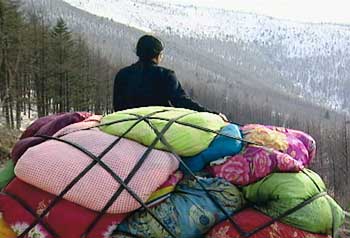The above video is excerpted from the Season 5 episode Systems, premiering on Wednesday, October 28, 2009 at 10pm (ET) on PBS (check local listings). Systems features four artists — John Baldessari, Kimsooja, Allan McCollum, and Julie Mehretu — who invent new grammars and logics, finding comfort in some systems while rebelling against others in today’s supercharged, information-based society.
Who is Kimsooja and what does she have to say about systems?
Kimsooja was born in 1957 in Taegu, South Korea; she lives and works in New York. Kimsooja’s videos and installations blur the boundaries between aesthetics and transcendent experience through their use of repetitive actions, meditative practices, and serial forms. In many pieces, everyday actions—such as sewing or doing laundry—become two- and three-dimensional or performative activities. Central to her work is the bottari, a traditional Korean bundle used to wrap and protect personal belongings, which Kimsooja transforms into a philosophical metaphor for structure and connection. In videos that feature her in various personas (Needle Woman, Beggar Woman, Homeless Woman), she leads us to reflect on the human condition, offering open-ended perspectives through which she presents and questions reality. Using her own body, facing away from the camera, Kimsooja becomes a void; we literally see and respond through her. While striking for their vibrant color and density of imagery, Kimsooja’s works emphasize metaphysical changes within the artist-as-performer as well as the viewer.
On the subject of systems in art, Kimsooja talks about blurring conceptual systems from art and life in her work (in the forthcoming Season 5 book):
When I was doing sewing pieces, I considered all the women’s activities—sewing, cooking, laundry, pressing, cleaning the house, shopping, decorating—as two- and three-dimensional or performative activities. I wanted to appreciate that aspect and reveal the artistic context. So my work was all, in a way, related to women’s activity, but then it was also linked to contemporary art issues. I’d been working a lot using femininity and female activities, but I never considered myself as a feminist. The only thing I can agree to is that ‘feminist’ is part of ‘humanist’. So I don’t even participate in feminist shows—because that really simplifies and limits my ideas. I refuse to be in a specific ism. But my practice can be perceived in different isms—like conceptualism, globalism, feminism, minimalism. My intention is to reach to the totality of our life in art, so that’s also one reason my practice is quite broad and diverse—to reach that complexity and comprehensiveness.
What happens in Kimsooja’s segment in Systems this October?
Kimsooja’s segment opens with a series of videotaped performances in crowded cities around the world, titled A Needle Woman (1999-2001). In the videos, the artist is shown from behind, her form acting as an unmoving axis on the horizon. Comparing her body to a needle that threads through space and time, she explains that her conceptual “system is very much rooted to the practice of sewing” and that she discovers “artistic questions and answers from our daily life activities.” Discovering that bottari—a traditional Korean bundle—could be used as minimalist sculpture, the artist later explored autobiographical and cultural aspects of the form in works such as a tour of South Korea in Cities On The Move–2727 km Bottari Truck (1997) and an installation of hanging bedsheets belonging to newlyweds in A Laundry Woman (2004).
The segment focuses in depth on two recent site-specific works. Lotus: Zone of Zero (2008) in Brussels consists of 2,000 fuchsia lotus lanterns with a soundtrack of Tibetan, Gregorian, and Islamic chants. To Breathe–A Mirror Woman (2006) is an intervention at the Crystal Palace in Madrid in which rainbow-colored sunlight, diffused through diffraction grating film applied to windows, is reflected in a mirrored surface applied to the floor while a pre-recorded performance of the artist’s rythmic breathing—A Weaving Factory (2005)—fills the space. Says the artist on her ethereal and genre-bending work: “My intention is to reach to the totality of our life in art.”

Kimsooja. "Cities On The Move - 2727 km Bottari Truck," 1997. Single channel video projection, silent, 7:33 minute loop. © Kimsooja, courtesy the artist.
What else has Kimsooja done?
Kimsooja earned a BFA (1980) and MA (1984) from Hong-Ik University, Seoul. Kimsooja has received the Anonymous Was a Woman Award (2002), among others, and has been an artist-in-residence at the World Trade Center, New York (1998); P.S. 1 Museum, New York (1992-93); and École Nationale Supérieure des Beaux-arts, Paris (1984). She has had major exhibitions at the Los Angeles County Museum of Art (2009); Hirshhorn Museum and Sculpture Garden, Washington, DC (2008); Museo Nacional Centro de Arte Reina Sofía, Madrid (2006); Magasin 3, Stockholm Konsthall, Sweden (2006); the MIT List Gallery, Cambridge (2005), and other institutions. Kimsooja has participated in international exhibitions, including the Venice Biennale (2001, 2005, 2007); Yokohama Triennial (2005); and Whitney Biennial (2002).
Where can I see more of Kimsooja’s work between now and the Art21 premiere this October?
Kimsooja maintains an extensive website of her work.
What’s your take on Kimsooja’s inclusion in Season 5?
Tell us what you think by leaving a comment below!




Pingback: my body as a needle passing through the pedestrians’ passing moments, weaving them into a tapestry « Salastia